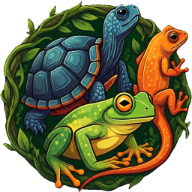
Phelsuma grandis
The Malagasy day gecko (Phelsuma grandis) originates from Madagascar and several smaller islands in the Indian Ocean. This gecko lives on tree trunks in lowland humid forests and occasionally comes to the ground to forage for food. They can grow up to 25 cm long (including the tail) and can live for 20 to 25 years. The geckos are bright green with red stripes or spots. Malagasy day geckos cannot blink; they clean their large eyes by licking them. They are diurnal and naturally found in plant-rich forested areas up to 1,000 meters above sea level. They have adhesive pads on their feet that allow them to climb smooth surfaces. Day geckos can shed their tails (autotomy) when they feel threatened, distracting the predator so the gecko can escape. The tail will grow back, but it will never look the same as the original. They can also shed their skin. Day geckos shed in pieces and eat their molted skin.
Enclosure
Day geckos are solitary animals. It is best to keep them alone, as they can be territorial towards others. Females can also exhibit territorial behavior towards each other. Housing them with other geckos can lead to significant stress, and they may fight, which can potentially result in death. Day geckos feel most comfortable when they are alone. Just because they tolerate one another doesn’t mean they enjoy it.
Day geckos do not drink from a water bowl, so they will drink water from the leaves of plants. A tank with live (untreated, non-toxic) plants is recommended. Live plants also help maintain humidity levels in the enclosure. The minimum size for the terrarium should be 45x45x90 cm; they prefer a tall enclosure rather than a wide one. Day geckos are excellent climbers and will take full advantage of height. Decorate the terrarium with smooth branches, with bamboo sticks being the best option. They require smooth surfaces for climbing. Inside the bamboo sticks, they can hide, and if one is placed horizontally under the heat spot, they will bask there. The terrarium should be densely planted, and the substrate must be at least 10 cm thick.
Temperature & Humidity
The temperature should be between 25-28 degrees Celsius, and the humidity should range from 60-95%. Therefore, choose a substrate that retains moisture well. Mist the terrarium twice a day or install a misting system. Under the lamp, the temperature can be 30-35 degrees Celsius. Ensure that the gecko cannot access the heat source to prevent burns. The terrarium should have good ventilation and be placed in a draft-free location. It's beneficial to include a background in the terrarium, as this contributes to stress reduction. They also need a day-night cycle of about 10-12 hours of light per day. You can create this by adding a timer. A lock is useful to keep children away from the terrarium. To synthesize vitamin D3, they need UV light. Reptiles produce vitamin D3 in their bodies through UV light, which is essential for calcium absorption. A UV lamp should be replaced once a year. It's best to opt for T5 or T8 lighting.
Care & Handling
Reptiles are primarily visual creatures and not pets for handling. This gecko is absolutely not suitable for handling. They have loose skin that can tear when grasped, potentially injuring your gecko. Additionally, they can bite quite hard. It is important to keep the terrarium clean. This can be achieved by making the terrarium bioactive (see bioactive caresheet). The substrate should be clean, and the glass and leaves should be free of feces, with any dead food items removed.
Food & supplements
This gecko primarily eats insects such as crickets, cockroaches (dubia), wax worms, silkworms, and grasshoppers. Mealworms can also be provided, but they are low in nutrients. The prey should be about as large as the gecko's mouth width. Feed as much as the gecko can consume. They can occasionally receive a fruit puree, which should be made with powder and water until it is as thick as ketchup. Occasionally, soft fruits such as papaya, banana, or peach can be offered. Citrus fruits are less suitable. The feeding dish should be placed high up, as they will not come down for it. Live prey should be dusted with calcium and vitamins. Calcium ensures strong bones, and vitamins contribute to the health of your reptile. This should not be done simultaneously; provide vitamins once a week and calcium on the other days. A varied diet is important, as it aids in the health of your reptile. Geckos grow quickly; they can reach maturity in about a year and a half to two years.
Conclusion & Difficulty
Giant day geckos are known for being easy and hardy lizards, showcasing an array of stunning colors that make them a perfect example of what it means to keep a reptile as a pet. You can create a very beautiful, aesthetically pleasing, and well-planted terrarium for them that enhances their vibrant appearance, but it is important to remember that these animals are not suitable for handling; they are best appreciated from a distance, allowing you to admire their beauty without causing them stress.
Difficulty 1 out of 5.
